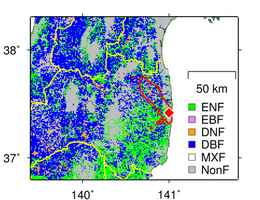福島県の森林における放射能汚染された物質の総量
The total amounts of radioactively contaminated materials in forests in Fukushima, Japan
2012年5月25日 Scientific Reports 2 : 416 doi: 10.1038/srep00416

福島第一原子力発電所の事故により、放射性物質が発電所から漏れ出した。汚染度の高い地域(今回は134, 137Csが1000 kBq m-2以上とした)は、発電所の北西部にあることがわかっている。汚染地域の大部分は森林である。今回我々は、汚染された森林地域におけるバイオマス、リター(土壌表面にある小さな有機物)、枯死木、土壌の量について報告する。総体積は33 Mm3(枝、葉、リター、枯死木は含まれない)、総重量は21 Tg(乾燥重量)と見積もられた。我々の結果は、リターの除去が除染の効率的な方法であることを示唆している。しかし、リターは常に分解されており、また汚染された葉は樹木から数年にわたって土壌表面に落ち続けるであろう。したがって、より多くの放射性元素が土壌に移行する前に、リターを迅速にしかし継続的に除去すべきである。
- 森林総合研究所 立地環境研究領域
There has been leakage of radioactive materials from the Fukushima Daiichi Nuclear Power Plant. A heavily contaminated area (≥ 134, 137Cs 1000 kBq m−2) has been identified in the area northwest of the plant. The majority of the land in the contaminated area is forest. Here we report the amounts of biomass, litter (small organic matter on the surface of the soil), coarse woody litter, and soil in the contaminated forest area. The estimated overall volume and weight were 33 Mm3 (branches, leaves, litter, and coarse woody litter are not included) and 21 Tg (dry matter), respectively. Our results suggest that removing litter is an efficient method of decontamination. However, litter is being continuously decomposed, and contaminated leaves will continue to fall on the soil surface for several years; hence, the litter should be removed promptly but continuously before more radioactive elements are transferred into the soil.

